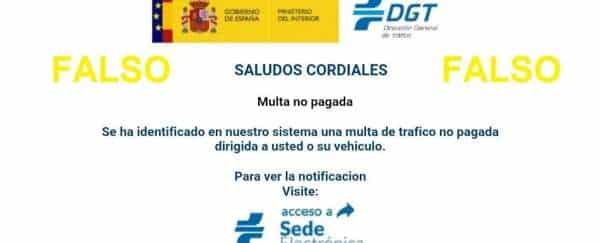If you get an email containing the words “multa” (fine) and DGT in your inbox, it’s almost certainly fake. It will be better to be suspicious rather than scared, and in any case, you should not click on any link contained in the email. Be assured, the DGT does not normally communicate sanctions by email.

Messages that seek to spread malicious software (and steal personal or banking data) arrive almost daily in mailboxes, according to the National Institute of Cyber Security (INCIBE), and the General Directorate of Traffic (DGT) is one of the common hooks.
Fraud campaigns are cyclical and massive and are usually based on the same thing: appearance of reality and threat, or invitation. In the mail there is an alleged message from the DGT -with their official logo and, sometimes even displaying that of the Ministry of the Interior-, in which the victim is told that there is a pending fine to pay or that the vehicle is immobilised, or sometimes both circumstances at the same time. The email also contains a link you are encouraged to click in order to resolve the issue. Do not click on links presented like this.
Those who send these messages rely on several pillars: haste, distraction, curiosity and fear. Users bite by inertia. To avoid the error (clicking and triggering the installation of a virus or other similar disasters), INCIBE offers some basic tricks.
How to spot a fake email
As general recommendations, the cybersecurity institute reminds users, for example, to check that the sender’s email is spelled correctly, both their name and domain (what appears after the @) and that in the body of the message there is no grammatical errors or a tone or vocabulary that does not correspond to what is expected. Any call to action, such as downloading a file or entering personal data or clicking on a link, should also be suspected.
INCIBE’s advice is useful for any circumstance, but it should not be necessary if the message comes from the DGT, because they do not normally communicate sanctions by email. Fines reach drivers or vehicle owners by certified letter, and as a secondary method, if the first has failed, they are published in the official bulletins or on the Town Hall bulletin board (physical or electronic), and always on the Edictal Board of Traffic Sanctions (TESTRA).
What is TESTRA and how to consult a fine
When a suspicious message appears, it only takes five minutes to check if that unknown fine exists. The query in the TESTRA can be done through the vehicle registration, the DNI or the name and surnames. It is not necessary to have a digital certificate or use the electronic DNI, because the data is public.
Since November 25, 2010, sanctions have been added to this electronic board, where the General Directorate of Traffic, the Basque Government Traffic Department, the Catalan Traffic Service and some 1,000 town councils publish their edicts.
You can find out more information and visit the board by visiting this website address:
https://sede.dgt.gob.es/es/multas/consulta-multa-tablon-edictal-unico/#
Dirección Electrónica Vial (DEV)
Fines will appear in the inbox only in one case: if the driver has registered with the Dirección Electrónica Vial (DEV). This free notification service replaces the postal address with an electronic one, but only if the user requests it. In this case, all fines and communications from the DGT (and from other administrations that use TESTRA) will arrive by email and, if desired, by SMS. While a driver is registered with the DEV, you stop receiving notifications on paper, but can unsubscribe whenever you want.
You can find out more information on this at the following website:
https://sede.dgt.gob.es/es/otros-tramites/direccion-electronica-vial/





